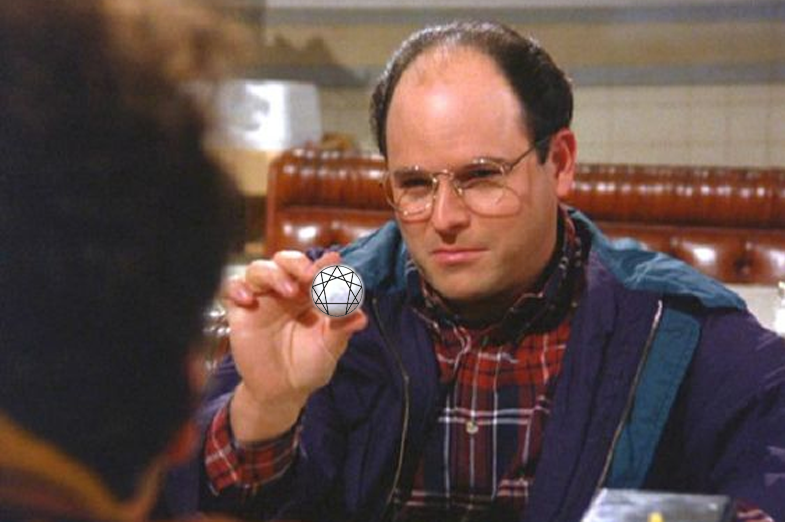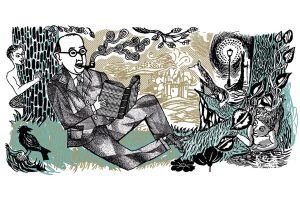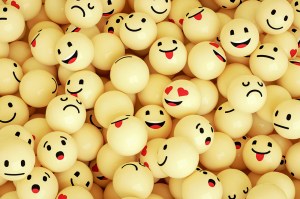To paraphrase Tolstoy, all happy people are alike but every unhappy person is unhappy in one of exactly nine ways. Thus contends the Enneagram, a personality-typing system popular among millennial Christians and lifestyle bloggers. Bestselling books and popular social-media accounts clarify and affirm each of the Enneagram’s nine ‘types’. There are Enneagram coaches, consultants and devotionals, and podcasts ranging from the whimsical (Say Enneathing) to the vaguely mystical (The Wisdom of the Enneagram).
The Enneagram is frivolous, self-indulgent and indefensible before science or theology. But I would say that: a Type 6 is skeptical. The truth is, I love the Enneagram. Though most modern Enneagraphers have stopped claiming that the Enneagram is ‘an ancient Sufi teaching’, they maintain that its nine-pointed symbol has ancient roots.
The icon does look rather significant, like a Star of David multiplied by a pentagram. The Greek-Russian mystic and dance therapist G.I. Gurdjieff encountered it ‘possibly in Afghanistan or Turkey’ and brought it to the New World in the early 20th century. You have to admit, it’s good branding.
The nine personality types were an innovation of the Bolivian philosopher Oscar Ichazo, who began teaching self-help courses using the model in the 1950s. One of his protégés, Claudio Naranjo, is credited with teaching a more contemporary version of the Enneagram to Jesuit priests, who adapted it for use in Christian spiritual practice — paving the way, perhaps, for its widespread
use among Christians today.
The Enneagram’s insight is that everyone is motivated by fear and desire in a limited number of combinations. We are different from each other, but not that different. For example, Type 2 (‘the Helper’), fears being unworthy of love and desires to be loved; this type can curdle into cloying neediness. Meanwhile, Type 7 (‘the Enthusiast’ or ‘the Epicure’) fears deprivation and desires happiness; this can deteriorate into manic escapism. In severe decline, the types start to resemble each other — all commit suicide at their lowest point, except for Type 8 (‘the Challenger’), whose last challenge is to commit genocide.We’ve all dated him.
Doesn’t everyone desire love and happiness? Yes, but the Enneagram suggests that if you consider the matter deeply, you’ll find that one craving — for control, security, self-expression, knowledge — directs your behavior above the others. The idea is that once you’ve identified your motivation, you can master it and achieve self-awareness and personal success.
Professional Enneagram practitioners — Enneagrammarians? — frown upon ‘typing’ other people, but that’s the best part: the Ennegram is the most efficient way to gossip yet invented. ‘She’s a Type 1,’ I’ll say to a fellow Enneagrammer about a bossy and meticulous coworker: a vivid portrait of nitpicking neuroticism with just one stroke. ‘He was a Type 8,’ I sigh about my ex boyfriend. The relationship’s demise is self-explanatory: this guy is literally Hitler.
This tool has pro-social uses, too. I learned this from my brother’s wife when she joined our family. Between us, we have 15 siblings and hundreds of close relations; how easy, at the wedding, to point to a Type 7 cousin who will join me on the dance floor, a Type 5 uncle who will seem standoffish at first and a Type 2 aunt who will be happy to help with the kids.
The Enneagram can be a remarkably efficient way to handle a room full of people — if you’re willing to bend the rules against typing friends, family, and slight acquaintances. Typing famous or fictional figures is a mainstay of Enneagram content. What do I have in common with Princess Diana, Rush Limbaugh and George Costanza? We’re all Type 6, ‘the Loyalist’. How about philosophers Plato, Noam Chomsky and Celine Dion? They are all Type 1, ‘the Reformer’. Ringo Starr is a Type 9, ‘the Peacemaker’, and Charlie Brown is a Type 4, ‘the Artist’. But we already knew that.
Enneagramming makes appealing, soothing sense out of a complicated world. Medievals subscribed to the quasi-medical concept of the four humors. Modern children’s entertainment frequently sorts its characters along similar lines. By adulthood, our desire to categorize has morphed into the corporately omnipresent Myers-Briggs Type Indicator, or into astrology, the preferred sorting system of trendy urban creatives. Merge this impulse with the iron law of the internet — ‘If it exists, there is bespoke lifestyle content in it’ — and you have the Enneagram.
Something else is at work here, too. The Enneagram experienced its publishing boom in the crunchy Nineties. But online searches for the topic were negligible until a rapid rise in 2017, coinciding, perhaps, with anxiety and political instability. The Enneagram is politically neutral, but Enneagram culture is dominated by white Christian Southern women. Perhaps it offers an emotionally satisfying alternative to the crassness of identity politics: a soft tribalism with a shared understanding, but without the stigma of joining an explicit out-group. And if a Facebook community dedicated to the trials and tribulations of ‘Type 3 Life’ is this demographic’s alternative to QAnon conspiracy-swapping, then that’s all to the good.
Personally, I prefer the funky Nineties paperbacks you find in Catskills bargain basements to the Instagram accounts or podcasts. It’s my small resistance to the unstoppable march of all concepts toward their eventual repackaging as Self-Care Tips. Goofy as it is, the Enneagram has actually given me useful insights into my personality and inspired many hours of conversation with friends and family – not just gossip. Whatever your type, I advise approaching the Enneagram with a Type 6’s healthy skepticism, but a Type 7’s sense of fun.
This article was originally published in The Spectator’s March 2021 US edition.


















